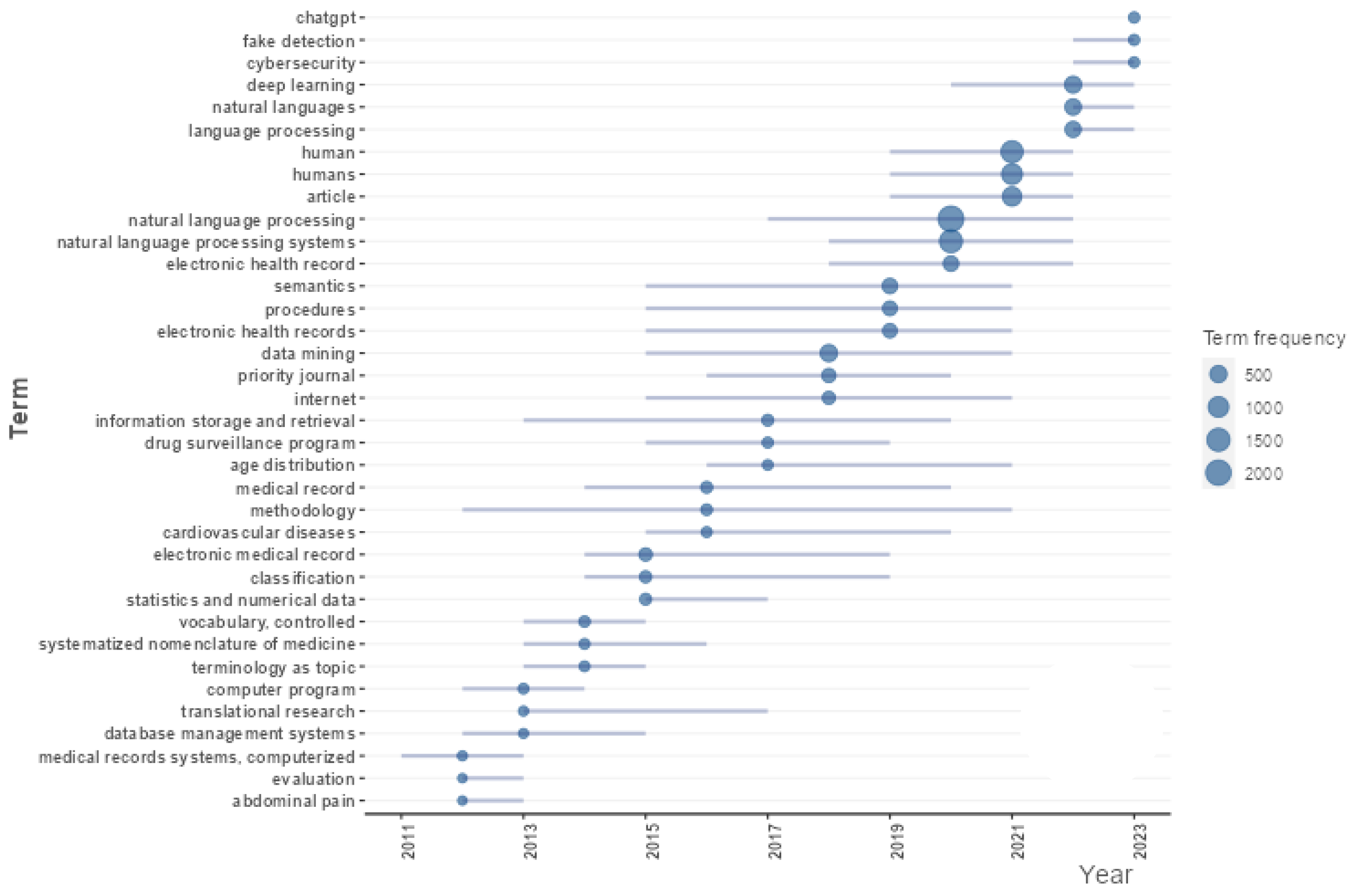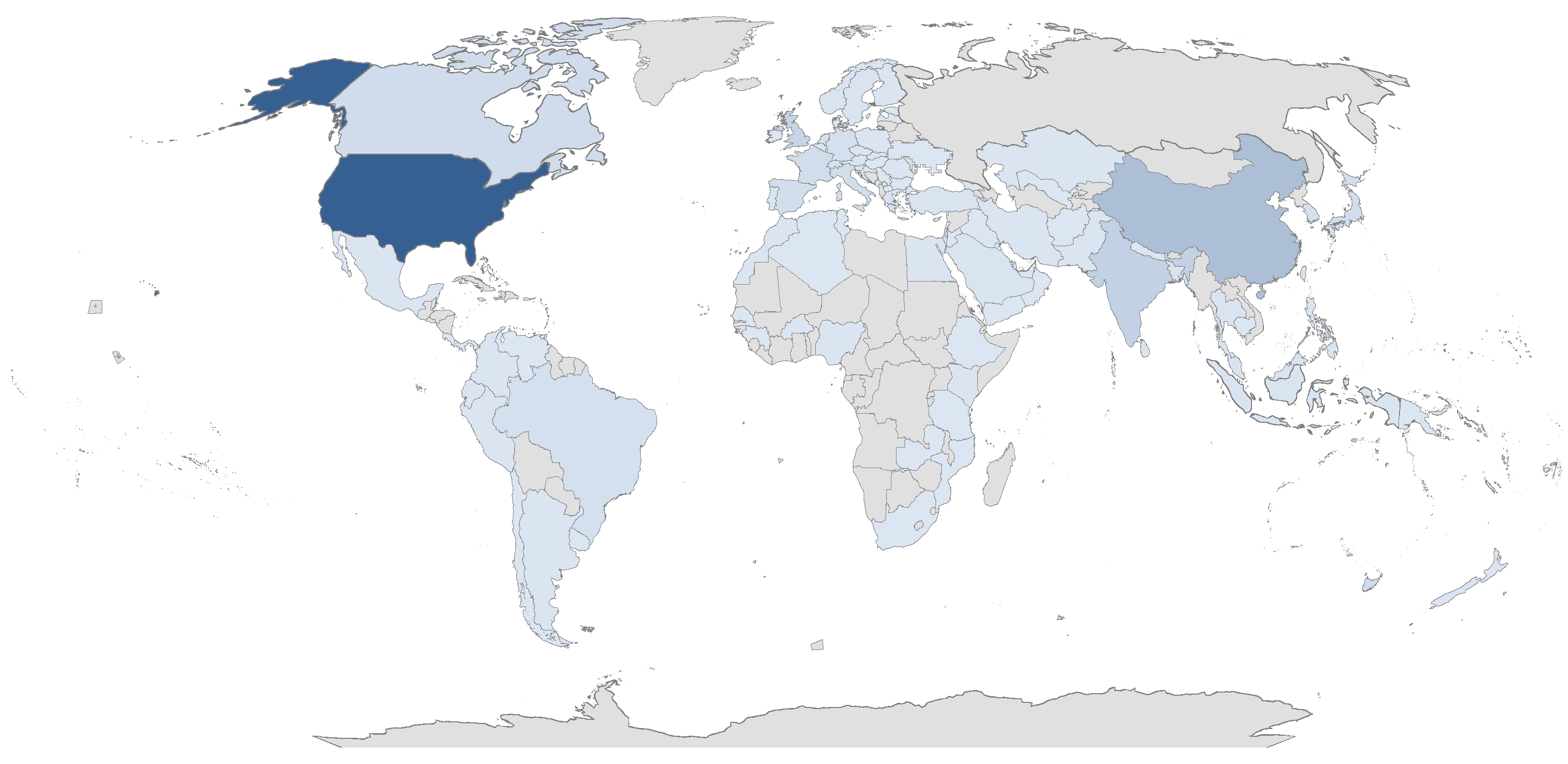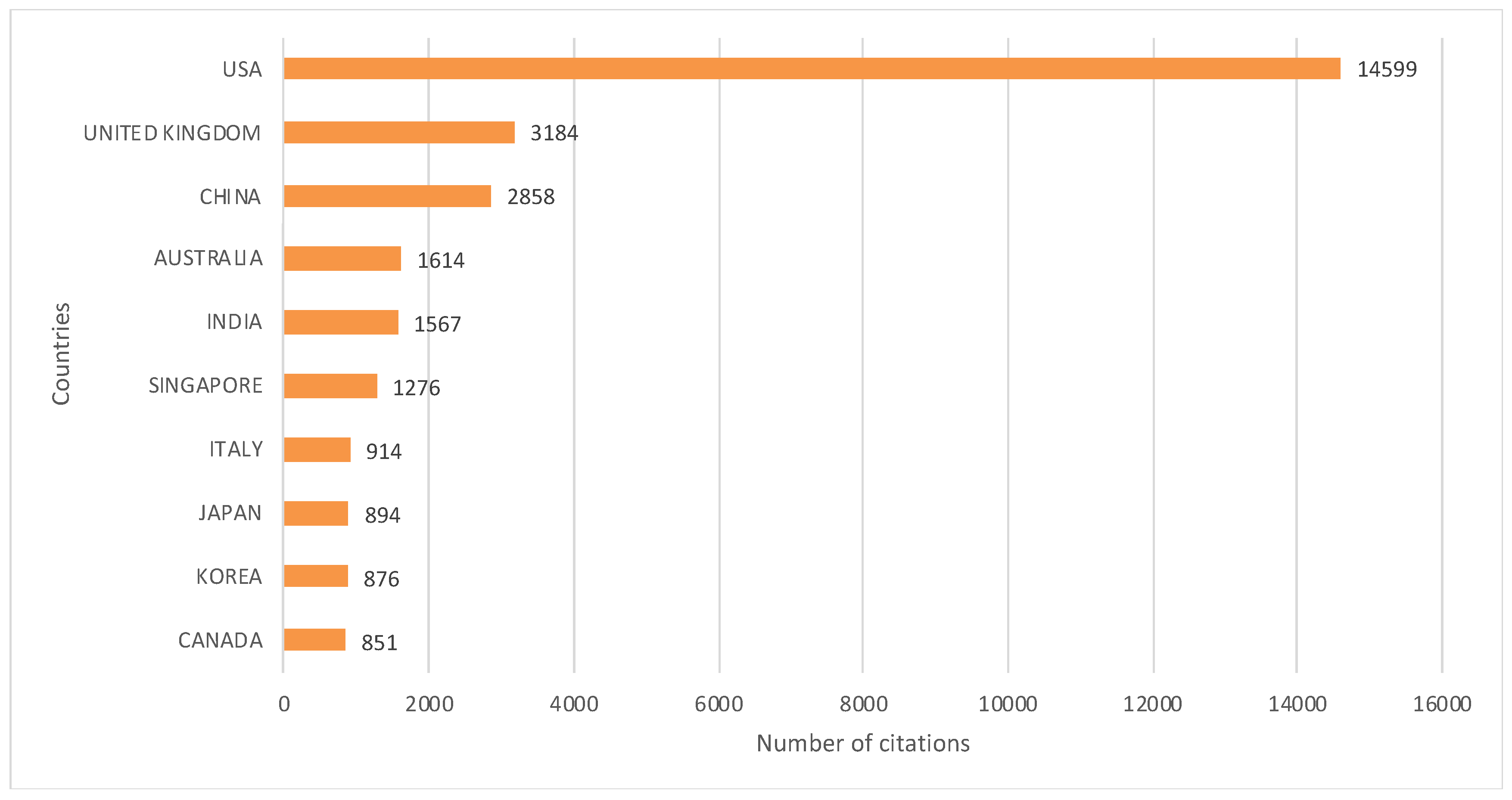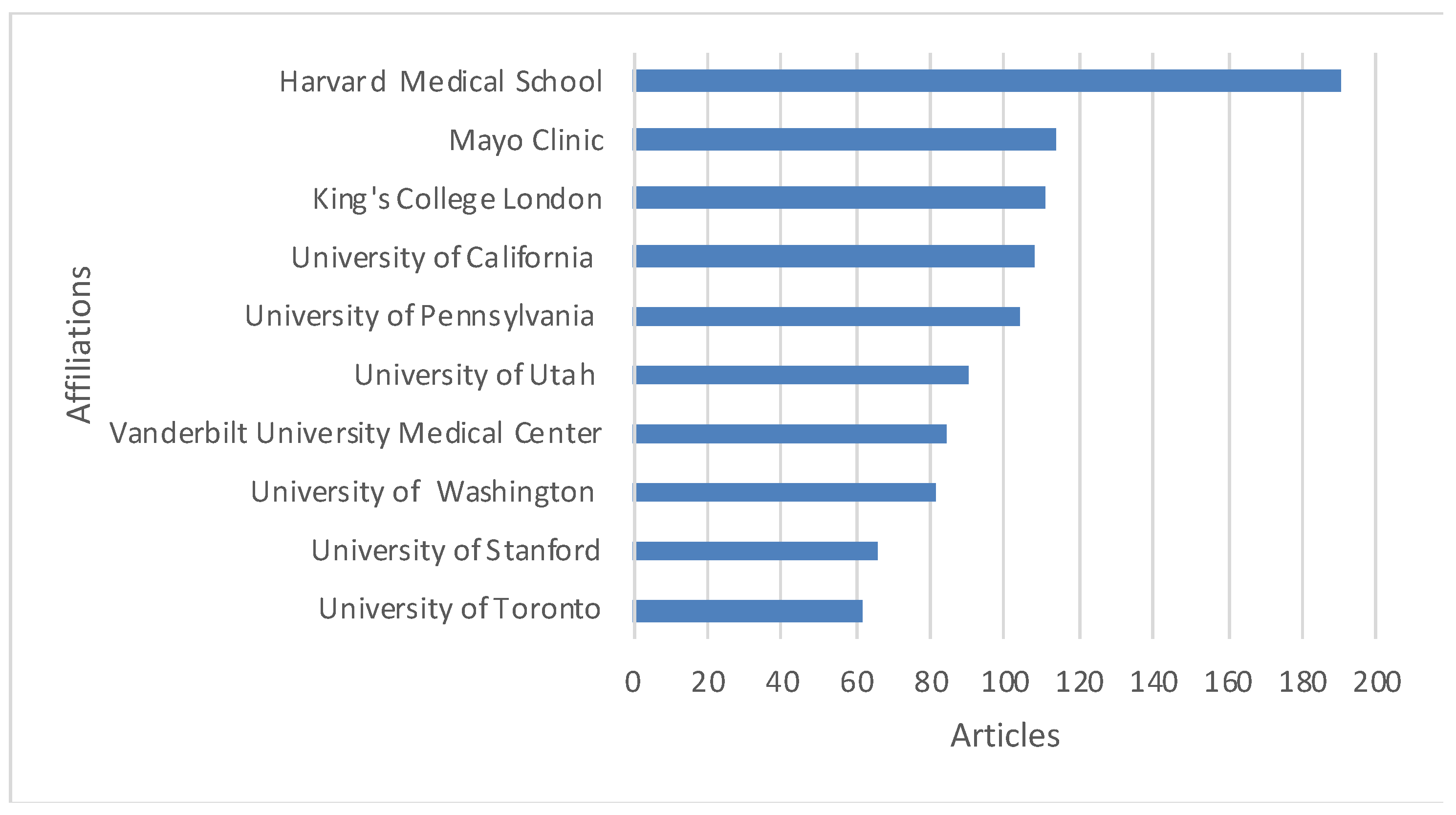The Research Interest in ChatGPT and Other Natural Language Processing Tools from a Public Health Perspective: A Bibliometric Analysis
Abstract
:1. Introduction
2. Materials and Methods
Analyses of Bibliometric Data
3. Results
3.1. Descriptive Analyses of Bibliometric Data
3.2. Evolving Trends in Research Interest
3.3. Leading Contributors and Collaborative Networks in Authorship
3.4. Top Countries of Contribution and Global Collaborative Networks
4. Discussion
5. Conclusions
Author Contributions
Funding
Institutional Review Board Statement
Informed Consent Statement
Data Availability Statement
Conflicts of Interest
References
- Kahambing, J.G. ChatGPT, public health communication and ‘intelligent patient companionship’. J. Public Health 2023, 45, e590. [Google Scholar] [CrossRef] [PubMed]
- Dave, T.; Athaluri, S.A.; Singh, S. ChatGPT in medicine: An overview of its applications, advantages, limitations, future prospects, and ethical considerations. Front. Artif. Intell. 2023, 6, 1169595. [Google Scholar] [CrossRef] [PubMed]
- Cascella, M.; Montomoli, J.; Bellini, V.; Bignami, E. Evaluating the Feasibility of ChatGPT in Healthcare: An Analysis of Multiple Clinical and Research Scenarios. J. Med. Syst. 2023, 47, 33. [Google Scholar] [CrossRef] [PubMed]
- Kung, T.H.; Cheatham, M.; Medenilla, A.; Sillos, C.; De Leon, L.; Elepaño, C.; Madriaga, M.; Aggabao, R.; Diaz-Candido, G.; Maningo, J.; et al. Performance of ChatGPT on USMLE: Potential for AI-assisted medical education using large language models. PLoS Digit. Health 2023, 2, e0000198. [Google Scholar] [CrossRef]
- Li, H.; Moon, J.T.; Purkayastha, S.; Celi, L.A.; Trivedi, H.; Gichoya, J.W. Ethics of large language models in medicine and medical research. Lancet Digit. Health 2023, 5, e333–e335. [Google Scholar] [CrossRef] [PubMed]
- Barrington, N.M.; Gupta, N.; Musmar, B.; Doyle, D.; Panico, N.; Godbole, N.; Reardon, T.; D’Amico, R.S. A Bibliometric Analysis of the Rise of ChatGPT in Medical Research. Med. Sci. 2023, 11, 61. [Google Scholar] [CrossRef] [PubMed]
- Liebrenz, M.; Schleifer, R.; Buadze, A.; Bhugra, D.; Smith, A. Generating scholarly content with ChatGPT: Ethical challenges for medical publishing. Lancet Digit. Health 2023, 5, e105–e106. [Google Scholar] [CrossRef] [PubMed]
- van Dis, E.A.M.; Bollen, J.; Zuidema, W.; van Rooij, R.; Bockting, C.L. ChatGPT: Five priorities for research. Nature 2023, 614, 224–226. [Google Scholar] [CrossRef]
- Baumgartner, C. The potential impact of ChatGPT in clinical and translational medicine. Clin. Transl. Med. 2023, 13, e1206. [Google Scholar] [CrossRef]
- Biswas, S.S. Role of Chat GPT in Public Health. Ann. Biomed. Eng. 2023, 51, 868–869. [Google Scholar] [CrossRef] [PubMed]
- Morita, P.P.; Abhari, S.; Kaur, J.; Lotto, M.; Miranda, P.A.D.S.; Oetomo, A. Applying ChatGPT in public health: A SWOT and PESTLE analysis. Front. Public Health 2023, 11, 1225861. [Google Scholar] [CrossRef] [PubMed]
- De Angelis, L.; Baglivo, F.; Arzilli, G.; Privitera, G.P.; Ferragina, P.; Tozzi, A.E.; Rizzo, C. ChatGPT and the rise of large language models: The new AI-driven infodemic threat in public health. Front. Public Health 2023, 11, 1166120. [Google Scholar] [CrossRef] [PubMed]
- King, M.R.; chatGPT. A Conversation on Artificial Intelligence, Chatbots, and Plagiarism in Higher Education. Cell. Mol. Bioeng. 2023, 16, 1–2. [Google Scholar] [CrossRef] [PubMed]
- Zhong, M.; Lin, M. Bibliometric analysis for economy in COVID-19 pandemic. Heliyon 2022, 8, e10757. [Google Scholar] [CrossRef] [PubMed]
- Prabakusuma, A.S.; Wardono, B.; Fahlevi, M.; Zulham, A.; Djoko Sunarno, M.T.; Syukur, M.; Aljuaid, M.; Saniuk, S.; Apriliani, T.; Pramoda, R. A bibliometric approach to understanding the recent development of self-sufficient fish feed production utilizing agri-food wastes and by-products towards sustainable aquaculture. Heliyon 2023, 9, e17573. [Google Scholar] [CrossRef] [PubMed]
- Camón Luis, E.; Celma, D. Circular Economy. A Review and Bibliometric Analysis. Sustainability 2020, 12, 6381. [Google Scholar] [CrossRef]
- Donthu, N.; Kumar, S.; Mukherjee, D.; Pandey, N.; Marc Lim, W. How to conduct a bibliometric analysis: An overview and guidelines. J. Bus. Res. 2021, 133, 285–296. [Google Scholar] [CrossRef]
- Sevillano-Jimenez, J.; Carrión-Chambilla, M.; Espinoza-Lecca, E.; Contreras-Pulache, H.; Moya-Salazar, J. A bibliometric analysis of 47-years of research on public health in Peru. Electron. J. Gen. Med. 2023, 20, em488. [Google Scholar] [CrossRef] [PubMed]
- Moura, L.K.B.; de Mesquita, R.F.; Mobin, M.; Matos, F.T.C.; Monte, T.L.; Lago, E.C.; Falcão, C.A.M.; de Arêa Leão Ferraz, M.Â.; Santos, T.C.; Sousa, L.R.M. Uses of Bibliometric Techniques in Public Health Research. Iran J. Public Health 2017, 46, 1435–1436. [Google Scholar]
- Md Khudzari, J.; Kurian, J.; Tartakovsky, B.; Raghavan, G.S.V. Bibliometric analysis of global research trends on microbial fuel cells using Scopus database. Biochem. Eng. J. 2018, 136, 51–60. [Google Scholar] [CrossRef]
- Aria, M.; Cuccurullo, C. bibliometrix: An R-tool for comprehensive science mapping analysis. J. Informetr. 2017, 11, 959–975. [Google Scholar] [CrossRef]
- Shah, N.H.; Entwistle, D.; Pfeffer, M.A. Creation and Adoption of Large Language Models in Medicine. JAMA 2023, 330, 866–869. [Google Scholar] [CrossRef] [PubMed]
- Frosolini, A.; Gennaro, P.; Cascino, F.; Gabriele, G. In Reference to “Role of Chat GPT in Public Health”, to Highlight the AI’s Incorrect Reference Generation. Ann. Biomed. Eng. 2023, 51, 2120–2122. [Google Scholar] [CrossRef] [PubMed]
- Haver, H.L.; Ambinder, E.B.; Bahl, M.; Oluyemi, E.T.; Jeudy, J.; Yi, P.H. Appropriateness of Breast Cancer Prevention and Screening Recommendations Provided by ChatGPT. Radiology 2023, 307, e230424. [Google Scholar] [CrossRef] [PubMed]
- Hermann, C.E.; Patel, J.M.; Boyd, L.; Growdon, W.B.; Aviki, E.; Stasenko, M. Let’s chat about cervical cancer: Assessing the accuracy of ChatGPT responses to cervical cancer questions. Gynecol. Oncol. 2023, 179, 164–168. [Google Scholar] [CrossRef] [PubMed]
- Yeo, Y.H.; Samaan, J.S.; Ng, W.H.; Ting, P.S.; Trivedi, H.; Vipani, A.; Ayoub, W.; Yang, J.D.; Liran, O.; Spiegel, B.; et al. Assessing the performance of ChatGPT in answering questions regarding cirrhosis and hepatocellular carcinoma. Clin. Mol. Hepatol. 2023, 29, 721–732. [Google Scholar] [CrossRef] [PubMed]
- Cao, J.J.; Kwon, D.H.; Ghaziani, T.T.; Kwo, P.; Tse, G.; Kesselman, A.; Kamaya, A.; Tse, J.R. Accuracy of Information Provided by ChatGPT Regarding Liver Cancer Surveillance and Diagnosis. AJR Am. J. Roentgenol. 2023, 221, 556–559. [Google Scholar] [CrossRef] [PubMed]
- Rahsepar, A.A.; Tavakoli, N.; Kim, G.H.J.; Hassani, C.; Abtin, F.; Bedayat, A. How AI Responds to Common Lung Cancer Questions: ChatGPT vs Google Bard. Radiology 2023, 307, e230922. [Google Scholar] [CrossRef] [PubMed]
- Cheng, K.; He, Y.; Li, C.; Xie, R.; Lu, Y.; Gu, S.; Wu, H. Talk with ChatGPT About the Outbreak of Mpox in 2022: Reflections and Suggestions from AI Dimensions. Ann. Biomed. Eng. 2023, 51, 870–874. [Google Scholar] [CrossRef]
- Kizito, S. ChatGPT has the potential to enhance antiretroviral therapy adherence among adolescents with HIV in sub-Saharan Africa. Med. Educ. Online 2023, 28, 2246781. [Google Scholar] [CrossRef] [PubMed]
- Deiana, G.; Dettori, M.; Arghittu, A.; Azara, A.; Gabutti, G.; Castiglia, P. Artificial Intelligence and Public Health: Evaluating ChatGPT Responses to Vaccination Myths and Misconceptions. Vaccines 2023, 11, 1217. [Google Scholar] [CrossRef]
- Sohail, S.S.; Madsen, D.; Farhat, F.; Alam, M.A. ChatGPT and Vaccines: Can AI Chatbots Boost Awareness and Uptake? Ann. Biomed. Eng. 2023, 52, 446–450. [Google Scholar] [CrossRef] [PubMed]
- Chlorogiannis, D.D.; Apostolos, A.; Chlorogiannis, A.; Palaiodimos, L.; Giannakoulas, G.; Pargaonkar, S.; Xesfingi, S.; Kokkinidis, D.G. The Role of ChatGPT in the Advancement of Diagnosis, Management, and Prognosis of Cardiovascular and Cerebrovascular Disease. Healthcare 2023, 11, 2906. [Google Scholar] [CrossRef]
- Sallam, M. ChatGPT Utility in Healthcare Education, Research, and Practice: Systematic Review on the Promising Perspectives and Valid Concerns. Healthcare 2023, 11, 887. [Google Scholar] [CrossRef] [PubMed]
- Ma, J.; Sheridan, R.P.; Liaw, A.; Dahl, G.E.; Svetnik, V. Deep neural nets as a method for quantitative structure-activity relationships. J. Chem. Inf. Model. 2015, 55, 263–274. [Google Scholar] [CrossRef]
- Ting, D.S.W.; Pasquale, L.R.; Peng, L.; Campbell, J.P.; Lee, A.Y.; Raman, R.; Tan, G.S.W.; Schmetterer, L.; Keane, P.A.; Wong, T.Y. Artificial intelligence and deep learning in ophthalmology. Br. J. Ophthalmol. 2019, 103, 167–175. [Google Scholar] [CrossRef] [PubMed]
- Budd, J.; Miller, B.S.; Manning, E.M.; Lampos, V.; Zhuang, M.; Edelstein, M.; Rees, G.; Emery, V.C.; Stevens, M.M.; Keegan, N.; et al. Digital technologies in the public-health response to COVID-19. Nat. Med. 2020, 26, 1183–1192. [Google Scholar] [CrossRef] [PubMed]
- Dharmage, S.C.; Perret, J.L.; Custovic, A. Epidemiology of Asthma in Children and Adults. Front. Pediatr. 2019, 7, 246. [Google Scholar] [CrossRef] [PubMed]
- Tasnim, S.; Hossain, M.M.; Mazumder, H. Impact of Rumors and Misinformation on COVID-19 in Social Media. J. Prev. Med. Public Health 2020, 53, 171–174. [Google Scholar] [CrossRef] [PubMed]










| Ranking | First Author | Year | Sources | DOI | Total Citations | Total Citations per Year | Normalized Total Citations |
|---|---|---|---|---|---|---|---|
| 1 | Socher R | 2012 | Conference on Empirical Methods in Natural Language Processing and Computational Natural Language Learning | NA | 1094 | 912 | 182 |
| 2 | Ma J | 2015 | Journal of Chemical Information and Modeling | 10.1021/ci500747n | 760 | 844 | 257 |
| 3 | Ting DSW | 2018 | The British Journal of Ophthalmology | 10.1136/bjophthalmol-2018-313173 | 615 | 1230 | 210 |
| 4 | Zhu L | 2019 | Advances in Neural Information Processing Systems | NA | 591 | 1182 | 202 |
| 5 | Budd J | 2020 | Nature Medicine | 10.1038/s41591-020-1011-4 | 538 | 1345 | 288 |
| 6 | Dharmage SC | 2019 | Frontiers in Pediatrics | 10.3389/fped.2019.00246 | 537 | 1074 | 183 |
| 7 | Xue L | 2021 | Conference of the North American Chapter of the Association for Computational Linguistics: Human Language Technologies | NA | 536 | 1787 | 493 |
| 8 | Aramaki E | 2011 | Conference on Empirical Methods in Natural Language Processing | NA | 517 | 398 | 156 |
| 9 | Kumar V | 2019 | Chemosphere | 10.1016/j.chemosphere.2019.124364 | 425 | 850 | 145 |
| 10 | Tasnim S | 2020 | Journal of Preventive Medicine and Public Health | 10.3961/jpmph.20.094 | 424 | 1060 | 227 |
| Ranking | Authors | Articles | Authors | Articles Fractionalized |
|---|---|---|---|---|
| 1 | Wang Y | 44 | Wang Y | 8.3 |
| 2 | Liu H | 31 | Zhang Y | 6.0 |
| 3 | Zhang Y | 27 | Li Y | 5.3 |
| 4 | Li J | 26 | Li J | 5.2 |
| 5 | Li Y | 26 | Sarker A | 4.8 |
| 6 | Liu Y | 26 | Liu Y | 4.8 |
| 7 | Wang J | 25 | Liu H | 4.2 |
| 8 | Sarker A | 23 | Wang H | 4.1 |
| 9 | Wang H | 20 | Wang J | 4.1 |
| 10 | Wang X | 20 | Wang X | 3.8 |
Disclaimer/Publisher’s Note: The statements, opinions and data contained in all publications are solely those of the individual author(s) and contributor(s) and not of MDPI and/or the editor(s). MDPI and/or the editor(s) disclaim responsibility for any injury to people or property resulting from any ideas, methods, instructions or products referred to in the content. |
© 2024 by the authors. Licensee MDPI, Basel, Switzerland. This article is an open access article distributed under the terms and conditions of the Creative Commons Attribution (CC BY) license (https://creativecommons.org/licenses/by/4.0/).
Share and Cite
Favara, G.; Barchitta, M.; Maugeri, A.; Magnano San Lio, R.; Agodi, A. The Research Interest in ChatGPT and Other Natural Language Processing Tools from a Public Health Perspective: A Bibliometric Analysis. Informatics 2024, 11, 13. https://doi.org/10.3390/informatics11020013
Favara G, Barchitta M, Maugeri A, Magnano San Lio R, Agodi A. The Research Interest in ChatGPT and Other Natural Language Processing Tools from a Public Health Perspective: A Bibliometric Analysis. Informatics. 2024; 11(2):13. https://doi.org/10.3390/informatics11020013
Chicago/Turabian StyleFavara, Giuliana, Martina Barchitta, Andrea Maugeri, Roberta Magnano San Lio, and Antonella Agodi. 2024. "The Research Interest in ChatGPT and Other Natural Language Processing Tools from a Public Health Perspective: A Bibliometric Analysis" Informatics 11, no. 2: 13. https://doi.org/10.3390/informatics11020013





